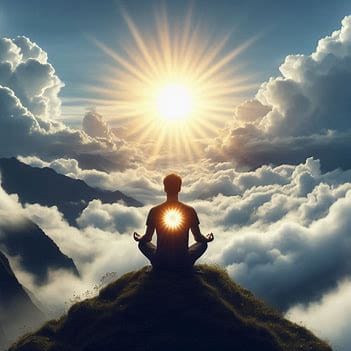Since the beginning of human civilization, philosophers have been engaged in a relentless pursuit to unravel the mystery of self-identity: "Who am I?"
Impermanence of the Physical Body
We all perceive the I and make statements like 'I am talking', 'I am walking', 'I am reading', and so on. However, the physical body that seems to be taking actions cannot be 'I', as it keeps changing year after year and eventually dies one day.
As we go down memory lane while looking at our photo album, we acknowledge the pictured individual as ourselves, yet the corporeal frame is different across those pictures.
The concept of the impermanence of the physical body has been validated by modern science. Research has proven that the process of regeneration is continuous in the body. Cells die out and new cells take their place. Within the space of 7 years all the cells in our body have been replaced with new ones. So, if our identity came from this matter that creates the body then the ‘I’ would also have changed multiple times.
Lets turn the pages of Vedic scriptures in this endeavor to discover our true self.
Ashtavakra Story to Help Discover Your True Self
The Vedas inform us that within the body is the unchanging atma (soul) which is the real 'I', the true self. The body is material, while the soul is divine. Because of its subtleness and divine nature, the soul is beyond the purview of our material senses.
Here's an illustrative story from the Vedas:
King Janak, ruler of Mithila and father of Sita, is known for his wisdom.
In a frightening dream one night, he witnessed the enemy Kingdom launch a vicious attack against him, leading to the devastating destruction of his army. Eventually, Janak found himself kneeling before the victorious Monarch, pleading for mercy. The king who had conquered said, "I offer you a single chance to disappear from my sight. Should we discover you after sunrise tomorrow, you will not survive."
Janak, ran towards the forest. In his fright, he kept on running deeper and deeper into the forest until it was night. Now he was extremely hungry and thirsty. He begged for food from a tribal villager’s hut, who gave him rations and a stove. As soon as Janak served the prepared food on a banana leaf. Out of nowhere, two hogs, fighting with each other, knocked over the banana leaf. That was the last straw for King Janak. Seeing the food become inedible, his grief knew no bounds and he began veiling in distress.
That misery broke his dream. On waking up he discovered his comfortable palace and its bedroom.
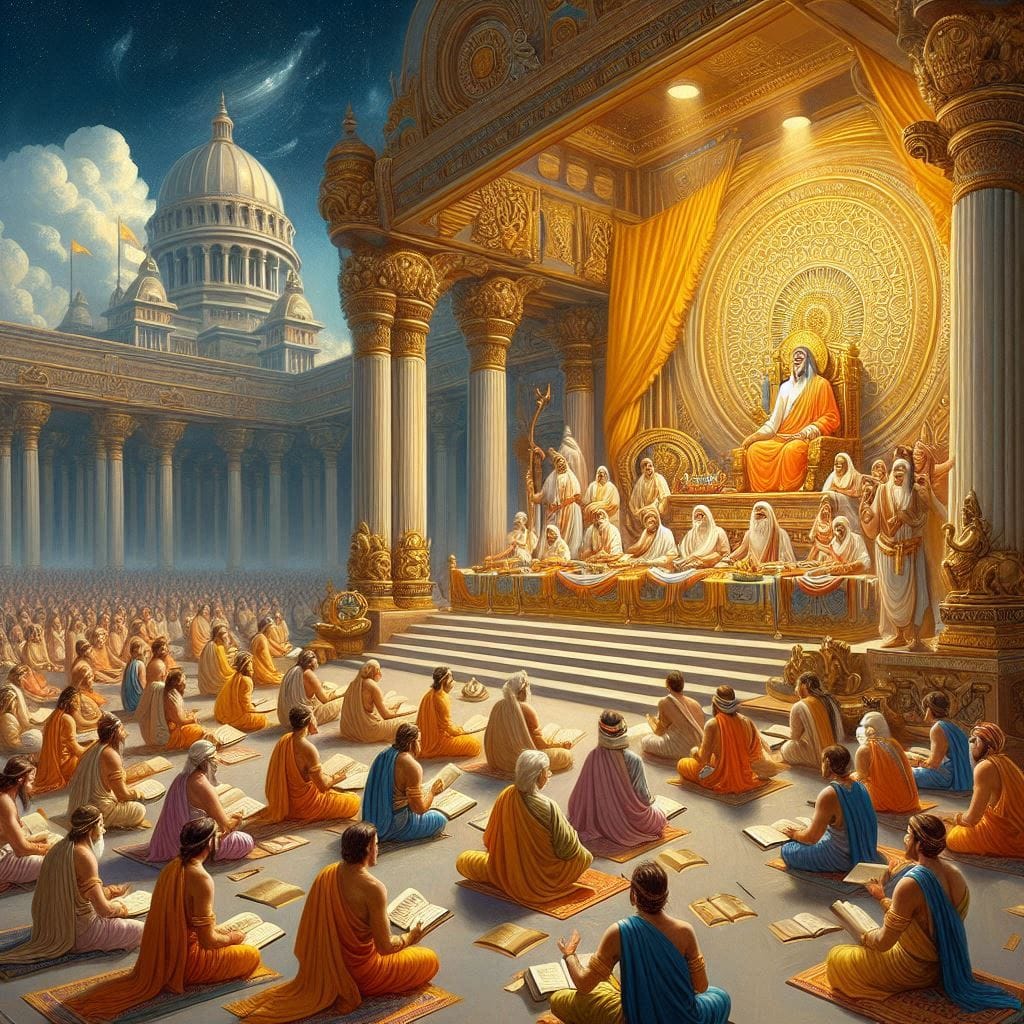
However, this experience set him thinking about which of these realities was true. He pronounced a challenge for the intellectuals in his kingdom to illuminate him on the nature of the truth. Many scholars were tempted by the rewards he had offered but in their attempts they failed until Ashtavakra appeared.
Ashtavakra was an astonishing personality in Indian history.
When he was in the womb of his mother, his father would recite Vedic knowledge and Ashtavakra, sitting inside would find mistakes that hurt his father's pride. "You are so conceited. You are not yet even born and you are finding flaws in my Vedic understanding. Go become crooked in eight places." So poor Ashtavakra, when he was born, had a body that was crooked in eight different joints.
Ashtavakra took up the challenge of Janak and appeared in his court where the greatest scholars of the time were present. Seeing this deformed child walking in, they all broke into laughter. Ashtavakra was not to be put down. He said in a strong commanding voice, "Janak, I had heard that the biggest Scholars of Bharat sit in your court. But here I am seeing all cobblers and shoe makers sitting." Now that statement stunned the entire assembly into silence.
But the wise Janak understood and said, "Oh Sage, you have called these scholars as cobblers, they wish to know why they have been insulted like this."
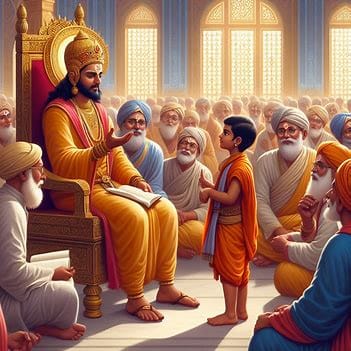
Ashtavakra said, "The answer should have been evident; they are looking at my height; my skin and reaching a decision. They do not even know that the self is beyond the body. In fact it is even beyond the mind."
Ashtavakra then Illuminated Janak and responded to his question about which reality is the truth.
"The truth is that which always exists!"
He then asked Janak, "The situation you found yourself in as a harrowed king running away from a conqueror, does it exist now?" Janak said "No". Ashtavakra continued, "Likewise your current comfortable situation did not exist in the dream. So both of these are not the Eternal truth. However there is one entity that has remained unchanged through all of these experiences and that is the entity within yourself from which you derive consciousness. This entity is the soul."
What is soul? Medical Science does not know of the existence of soul through its material instruments and yet they validate Ashtavakra's viewpoint in different ways. The findings of certain scientific studies indicate that our brain creates a carefully constructed hallucination of the reality we are in. This corroborates Ashtavakra's point; that between all the changing experiences is the unchanging reality of the soul which is our true self. Let us turn to the Vedas to gain scriptural insight into the soul and its attributes.
Proof of Soul in the Body is the Consciousness
In this effort to discover your true self, it might be logical to examine what keeps the physical body alive and functioning. Our body is made from matter. However, all matter is lifeless. Hence the body by itself cannot be the reason for life. How then is the body retaining its consciousness and what leaves the body when it is declared dead?
Science, too, realizes this paradox and is grappling to explain the phenomenon of consciousness. If matter could be manipulated to create Consciousness, then scientists would do the same in laboratories. However, nobody has ever succeeded in creating life from matter. Philosophers therefore continue to debate over the origin of consciousness.
The Vedas explain that life or sentience originates from the soul, which is our true self. As long as the soul is present in the body, the brain heart kidneys and liver continue to function. Once the soul departs, the organs are still there, but the functions seize. The body is now deemed dead. Hence consciousness or life comes from the soul.
Watch Swami Mukundananda explain consciousness:
What is soul and consciousness
Soul Energizes the Entire Body
One can wonder, how a tiny soul can make the dead matter of the body alive. This can be understood with the analogy of the flower in the garden. A flower is inherently fragrant. When it grows in the garden, it also makes the garden aromatic by its presence.
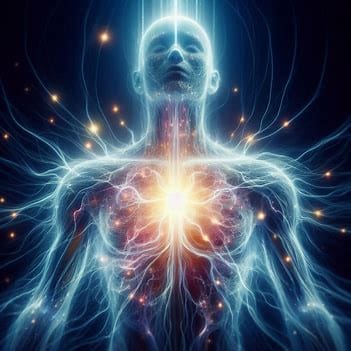
Vedant Darshan 2.3.25 states:
guṇādvā lokavat
“The soul, although seated in the heart spreads its consciousness throughout the field of the body.”
Bhagavad Gita also states in Chapter 13, Verse 34
yathā prakāśhayaty ekaḥ kṛitsnaṁ lokam imaṁ raviḥ
kṣhetraṁ kṣhetrī tathā kṛitsnaṁ prakāśhayati bhārata
"Although situated in one place, the sun illumines the entire solar system with its light. Similarly, the soul makes the entire body sentient with its consciousness."
Let us dig into the Vedas to find out further attributes of the soul.
Location of the Soul in the Body
If we agree on the existence of soul which is keeping our body alive and functioning, the question naturally arises about its whereabouts in the body.
The Vedas claim that the soul resides in the heart. It refers to the ethereal heart, not the physical heart organ.
hṛidi hyeṣha ātmā (Praśhnopaniṣhad 3.6) [v18]
sa vā eṣha ātmā hṛidi (Chhāndogya Upaniṣhad 8.3.3) [v19]
The word hṛidi indicates that the soul is seated in the region of the heart.
Size of the Soul
As per the Vedas, the soul does not have a physical form or physical boundaries, according to the Vedic wisdom.
Some Vedic philosophers propounded that soul is infinite (Vibhu). They see it as inseparable from God. If this were true, then the notion of going to hell or heaven after death would become irrelevant. An infinite soul would theoretically permeate the realms of earth, heaven, and hell, obviating any need for transitions between these domains.
Another viewpoint is that the soul takes the size of the body it inhabits. This also raises a dilemma for the process of reincarnation. For instance, if a soul occupies an elephant's body in one life, how will it fit in the diminutive pigeon's body in the next?
Yet another proposition that the soul infinitesimally small seems to be the most viable one. Evidence supporting this idea is abundant in the Vedic texts.
Muṇḍakopaniṣhad [3.1.9] states:
eṣho ’ṇurātmā
“The soul is very tiny in size.”
The Śhwetāśhvatar Upaniṣhad [5.9] states:
bālāgraśhatabhāgasya śhatadhā kalpitasya cha
bhāgo jīvaḥ sa vijñeyaḥ sa chānantyāya kalpate
“If we divide the tip of a hair into a hundred parts, and then divide each part into further hundred parts, we will get the size of the soul. These souls are innumerable in number.”
These Vedic mantras reveal that the soul is minuscule in size.
Soul is Immortal
The process of giving up the old body is looked upon as 'death' and taking on a new body is called 'birth'. What we term as 'death' is merely the soul changing bodies.
The Bhagavad Gita states in chapter 2, verse 22
vāsānsi jīrṇāni yathā vihāya
navāni gṛihṇāti naro ’parāṇi
tathā śharīrāṇi vihāya jīrṇānya
nyāni sanyāti navāni dehī
"As a person sheds worn-out garments and wears new ones, likewise, at the time of death, the soul casts off its worn-out body and enters a new one."
Soul in Sleeping State is Suffering
The soul is supposed to be the director of the intellect, mind and senses. However, instead of taking charge, the soul is sleeping. As a result, it is suffering through repeated cycles of birth and death bearing fruits of good and bad karma of the materially conditioned intellect, mind and senses.
The Vedas present the analogy of a chariot to help us grasp the soul's executive position:
Imagine a chariot with five horses pulling it. They have reins in their mouth. The reins are in the hands of a charioteer. A passenger is sitting at the back of the chariot. In this analogy:
- the chariot represents the body
- the horses symbolize the five senses
- the reins connecting to the horses' mouths represent the mind
- the charioteer embodies the intellect
- the passenger seated behind signifies the soul dwelling in the body
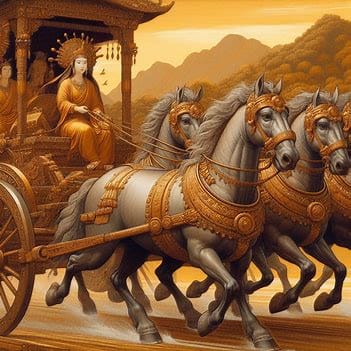
Ideally the passenger of the chariot should provide guidance to the charioteer, who, in turn, should use the reins to steer the horses in the right direction. However, in this case, the passenger, the soul, is asleep, so the chariot is veering directionless. In this state, the intellect is in control of the mind. The mind is busy fulfilling the desires of senses.
In this way, in the materially conditioned state, the soul has relinquished control of the chariot. Instead it is a passive observer, vicariously experiencing the pleasures and pains of the mind and senses. Seated on this chariot, the soul (passenger) has been roaming in the material world since eternity.
However, if the soul awakens and takes charge, it can inspire the intellect in the right direction. The intellect then assumes its rightful role as the charioteer and governs the mind. And the mind, in turn, manages the senses. Consequently, the chariot embarks on its journey to eternal welfare. The unfoldment of the infinite glory of the soul is the essence of spiritual science.
Check: Spiritual Secrets from Hinduism by Swami Mukundananda to delve deeper into the concepts of Vedic wisdom.

